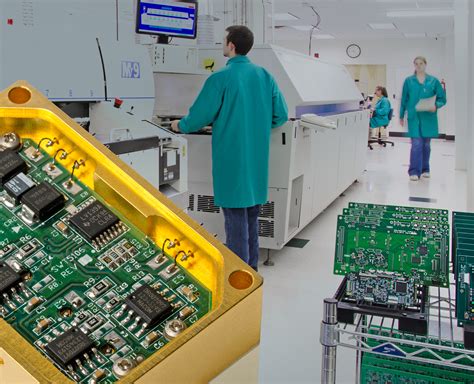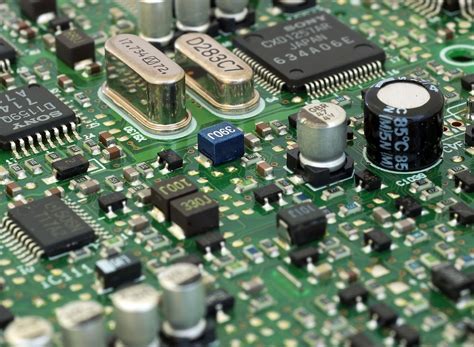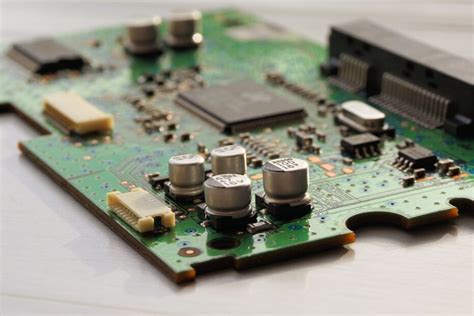How to easily achieve reliable and efficient industrial PCB connection?
Letting machines replace people to work is a main theme of human social development, and efforts and attempts around this vision have never stopped. In the second half of the 20th century, people introduced the concept of “automation” in industrial manufacturing, that is, using various technologies, methods and tools to minimize human intervention in the production process, making the entire process more efficient, fast and error-free. From then on, humans officially entered the era of industrial automation.
Entering the 21st century, humans have taken another big step forward on the basis of industrial automation. The concept of Industry 4.0 was proposed, and its main purpose is to promote the digital transformation of industry through various information technologies, release the huge potential hidden in data, and lead industrial manufacturing into the era of intelligence.
However, no matter how industrial automation evolves, at the production site, the final foothold of various analyses, decisions and controls is mainly on the drive of the motor as the executive component – allowing the motor to move in a timely and accurate manner according to the control instructions is an indispensable key link. Inverters and servo drives are very common devices for completing motor drive in industrial automation.
Connection challenges of motor drive solutions
The working principle of the inverter is to first convert the industrial frequency AC power supply into DC power supply through a rectifier, and then convert the DC power supply into an AC power supply with controllable frequency and voltage, and achieve motor speed regulation by changing the frequency of this AC power supply. The inverter usually consists of four parts: a rectifier unit, an intermediate circuit, an inverter and a controller, and is suitable for driving variable frequency motors and ordinary AC motors.
The servo drive is a more complex and precise motor drive device. It is based on the open-loop controlled AC and DC motor. The speed and position signals obtained through the rotary encoder, rotary transformer, etc. are fed back to the drive for closed-loop negative feedback PID adjustment control. In addition, the current closed-loop adjustment inside the drive makes the output position, orientation, state and other controlled quantities automatically adjusted according to the changes of the input target (such as displacement or angle), forming a follow-up system that can achieve dynamic balance.
The technical architecture and characteristics of both the inverter and the servo drive determine that they are suitable for different application scenarios. Generally speaking, the inverter system is relatively simple, low-cost, and higher-power, and is suitable for use in scenarios where speed and torque control requirements are not very high; while the servo drive has the characteristics of high precision, high performance, and high response, and is more suitable in scenarios with strict position control requirements.

Figure 1: Inverter (left) and servo drive (right)
(Source: Phoenix Contact)
Although the technical characteristics and application scenarios are different, in the tide of industrial automation development, the challenges faced by motor drive devices such as inverters and servo drives have many similarities. One of the topics that deserves attention is the challenge of PCB connectivity design.
On the one hand, with the improvement of the intelligence level of industrial equipment, more and more related sensors, control signals and data, as well as power supply need to be connected, so the design of external ports will be more complicated; on the other hand, with the increase of equipment functions, the internal architecture of industrial equipment will become more complex, and the difficulty of interconnection design between different internal components, modules and PCBs will also increase.
Moreover, the design of all these interconnection solutions must also meet the reliability requirements of miniaturization and industrial applications. In addition, it is worth noting that the design of industrial PCB connections also needs to take into account the requirements of on-site assembly and maintenance, and simplify the connection process as much as possible to make the connection operation easier and more efficient.
All these design challenges are transformed into requirements for the PCB connection design of inverters and servo drives, which can be summarized into the following four points:
- Have reliable electrical connection characteristics
- Adapt to the application requirements of compact space
- Support simple and efficient matching operations
- Provide flexible and diverse scalability
The good news is that Phoenix Contact’s full range of industrial PCB connection products are designed to meet the above requirements. Whether it is an external port or an internal connection, developers can find an ideal solution from it! The following will recommend three representative products. I believe that their reliable and efficient connection characteristics will definitely make you unforgettable.
PTS and PTSA PCB Terminal Blocks
The function of PCB terminals is to reliably connect cables to PCBs. In the eyes of many people, this is a relatively simple interconnection component, but it still takes some thought to design a PCB terminal block that meets the requirements of industrial applications.
Take Phoenix Contact’s PTS and PTSA PCB terminal blocks as an example. In order to achieve more efficient and fast wiring, they use direct plug-in technology. No tools are required during assembly. The push-in spring connection technology can ensure the reliability of interconnection while quickly connecting. Compared with standard screw termination and solid wire plug-in options, this type of terminal block has faster wiring speed and very simple matching operation. In addition, PTS and PTSA PCB terminal blocks also have horizontal wire connections and integrated test points to quickly identify the correctness of the connection, providing convenience for users’ actual operation.
In terms of design flexibility and scalability, PTS and PTSA PCB terminal blocks also have very comprehensive considerations. For example, these product series provide 2 to 24-bit models to choose from; with 2.5, 3.5, 5 and 7mm pitch, rated current range from 2A to 12A, rated voltage from 160V to 320V; at the same time, different installation angle options are also available, including 45°, right angle, straight, horizontal and vertical products, which can meet diverse design requirements. Moreover, since these PCB terminals are assembled as a single piece, the number of poles or color coding can be easily customized to meet the user’s personalized design requirements.
It can be seen that the ease of use and flexibility of PTS and PTSA PCB terminals can meet the requirements of efficient connection in a wide range of industrial PCB connection scenarios, and are perfect for use in inverters and servo drives.

Figure 2: PTS and PTSA PCB terminals
(Source: Phoenix Contact)
COMBICON control terminals
As the name suggests, COMBICON control is a PCB terminal product for measurement and control applications. It includes two types: fixed and plug-in. The former is suitable for direct PCB wiring, while the latter can be adapted to plug-in connectors to provide quick connection in different directions such as horizontal, vertical or tilted.

Figure 3: COMBICON control terminals
(Source: Phoenix Contact)
Easy to use, reliable and efficient – these are the very prominent features of COMBICON control terminals. To achieve this design goal, COMBICON control terminals use different connection methods such as screws, push-in springs, piercing and crimping. These connection solutions have their own characteristics and can meet the specific requirements of different applications. They can greatly simplify the matching operation process while ensuring reliable electrical connections, setting an industry benchmark.

Figure 4: COMBICON control terminals use a variety of connection methods (Source: Phoenix Contact)
In addition, COMBICON control terminals also include explosion-proof certified products. These products have passed the IEC/EN 60079-0 and IEC/EN 60079-7 standards. For those devices working in potentially explosive environments, this type of PCB terminal is obviously the best choice.
MKKDS series fixed terminal blocks are a representative product in COMBICON control. They adopt a double-row design with high wiring density. And because the layers are staggered, it is very convenient for wiring operations. This product provides 3.5mm and 5mm pin pitches, compact appearance, and screw wiring can ensure the stable connection of cables, so it is very suitable for the design of related products such as inverter control circuit interface.

Figure 5: MKKDS series fixed terminal blocks
(Source: Phoenix Contact)
In terms of COMBICON control pluggable connectors, the DFMC series is a recommended product. This connector is a double-row ultra-thin connector with 2.54mm and 3.5mm pin pitches and a compact appearance; it uses spring wiring and provides optional screw top flanges and lock-release rods. When the lock-release rod is released, it can play a boosting role, taking into account the stability and convenience of the connection, and is suitable for application scenarios such as servo drive control circuit interfaces.

Figure 6: DFMC series pluggable connectors
(Source: Phoenix Contact)
With excellent features, a rich product portfolio, and compatibility with automated production processes such as wave soldering, COMBICON control terminal blocks always play an important role in PCB connections of industrial automation equipment.
Ubiquitous data connection
As industrial automation relies more and more on data, connectors and communication interfaces that provide reliable data transmission are increasingly used in inverters and servo drives.
Board-to-board connectors are an important technical path to achieve high-density PCB interconnection and more compact design. Phoenix Contact’s FINEPITCH board-to-board connector provides an ideal solution for internal PCB connections in industrial equipment. This connector series offers products with various pitches from 0.635mm to 2.54mm, which can meet the needs of personalized PCB layouts such as various designs, stacking heights and number of digits. The products can also support mezzanine, coplanar, and motherboard-daughtercard connections, providing great flexibility for design.

Figure 7: FINEPITCH board-to-board connector
(Source: Phoenix Contact)
Take the FINEPITCH 0.8mm board-to-board connector (FP 0,8 series) as an example. In order to achieve reliable and efficient connection, it has carried out a series of design optimizations.
● First, the FP 0,8 series board-to-board connector adopts the innovative ScaleX technology. Its double contact design supports a variable mating length of up to 1.5mm, which can ensure reliable and stable connection.
● Secondly, the board-to-board connector can provide high tolerance compensation, and the good shell structure can effectively protect the contacts, which brings great convenience to the mating operation.
● In addition, the shielded products provided by the FP 0,8 series adopt a unique closed shielding concept to achieve excellent electromagnetic compatibility (EMC) protection and excellent signal integrity, which enables it to support data transmission rates of up to 52Gbps.
● Finally, the FP 0,8 series board-to-board connectors have a rich product portfolio, with a variety of digits, 6 to 18mm stacking height, and different types of shielded and unshielded products, which can bring great freedom to design.

Figure 8: FP 0,8 series board-to-board connectors use innovative ScaleX technology (Source: Phoenix Contact)
In short, the FINEPITCH series board-to-board connectors have excellent flexibility and can achieve signal and data transmission in a small space. They are very suitable for internal connections of industrial PCB devices such as inverters and servo drives, meeting their miniaturized and multi-functional design requirements.
In terms of communication interfaces, Phoenix Contact also has a very rich product portfolio. For example, for industrial-grade RJ45 connectors that support industrial Ethernet connections, Phoenix Contact can provide a full range of products, including equipment-side, field-side, and prefabricated cable products. These products include different configurations, such as 90° and 180° mating directions, single-port and multi-port sockets, and support for five outlet directions. Moreover, Phoenix Contact’s RJ45 connectors all meet the requirements of wave soldering/SMD/THR processes and support the requirements of automated mass production.

Figure 9: Phoenix Contact’s RJ45 connector
(Source: Phoenix Contact)
Phoenix Contact’s D-SUB connectors are suitable for interconnection of signals such as inverter encoder interfaces, including pin and socket types, as well as signal interfaces such as 9/15/25/44, and also provide power + signal hybrid interfaces, with a complete range of products. These D-SUB connectors are easy to assemble and can be used with IP67 plug housings and panel mounting frames to meet more stringent sealing requirements in industrial applications.

Figure 10: Phoenix Contact D-SUB connector
(Source: Phoenix Contact)
Summary
The development of industrial automation has brought new challenges to PCB connections in industrial equipment such as inverters and servo drives. Reliable and efficient PCB connection solutions have become the goal pursued by developers.
Phoenix Contact’s rich interconnect product portfolio for industrial applications – including PCB terminal blocks, plug-in connectors, board-to-board connectors, and RJ45 and D-SUB connectors – can well meet this design requirement and help developers quickly create ideal solutions.






